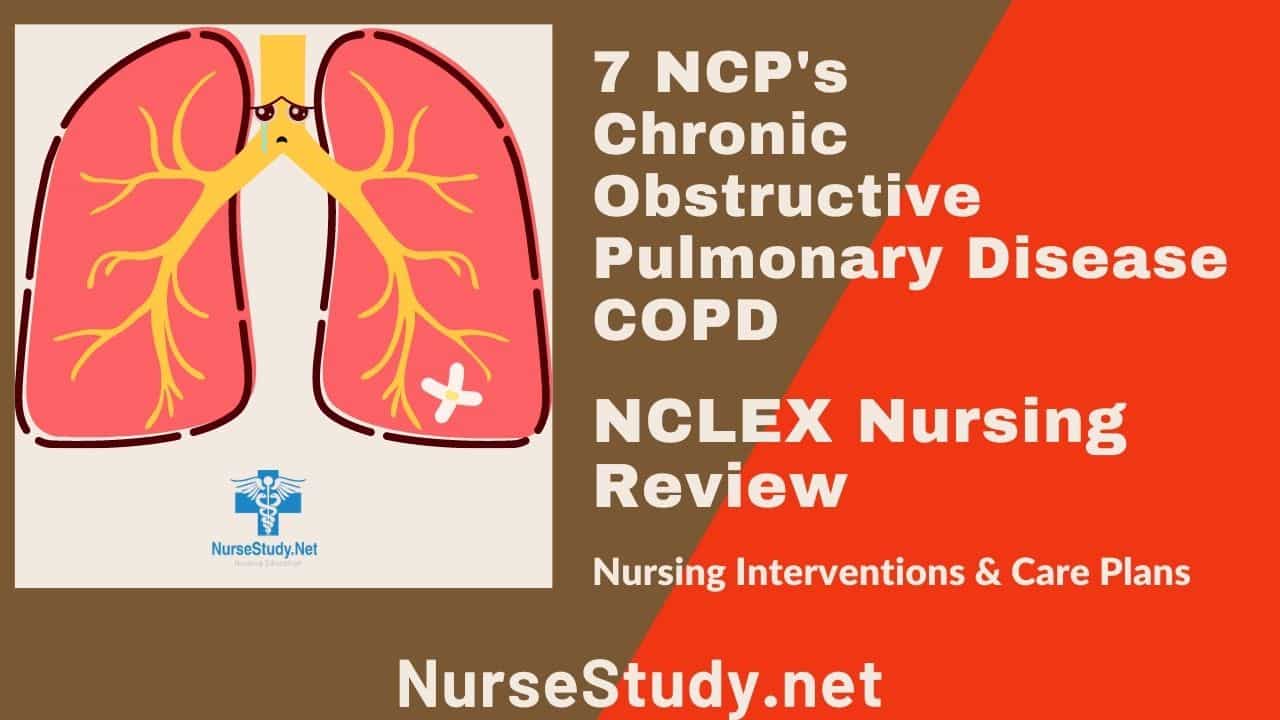Chronic Obstructive Pulmonary Disease (COPD) is a progressive respiratory condition that requires skilled nursing care and comprehensive management. This guide provides detailed nursing diagnoses, interventions, and care plans to help healthcare professionals deliver optimal care for patients with COPD.
Understanding COPD
COPD encompasses chronic bronchitis and emphysema, characterized by airway obstruction, inflammation, and breathing difficulties. As a progressive condition, COPD significantly impacts patients’ quality of life and requires ongoing nursing assessment and intervention.
Nursing Process for COPD
Assessment
Respiratory Assessment
- Monitor breathing patterns and rate
- Assess for use of accessory muscles
- Listen for adventitious breath sounds
- Evaluate oxygen saturation levels
Physical Assessment
- Check for cyanosis
- Observe for barrel chest
- Monitor for signs of right-sided heart failure
- Assess nutritional status
Diagnostic Tests
- Spirometry results
- Arterial blood gases
- Chest X-rays
- Complete blood count
Implementation
Nurses play a crucial role in:
- Medication administration
- Oxygen therapy management
- Patient education
- Monitoring for complications
- Coordinating care with the healthcare team
COPD Nursing Care Plans
1. Ineffective Breathing Pattern
Nursing Diagnosis Statement:
Ineffective Breathing Pattern related to airway inflammation and bronchial obstruction as evidenced by dyspnea, use of accessory muscles, and abnormal breathing patterns.
Related Factors:
- Airway inflammation
- Mucus accumulation
- Anxiety
- Fatigue
- Decreased lung compliance
Nursing Interventions and Rationales:
- Position patient in semi-Fowler’s position
Rationale: Promotes optimal lung expansion - Teach pursed-lip breathing
Rationale: Improves ventilation and reduces air trapping - Monitor respiratory rate and oxygen saturation
Rationale: Early detection of deterioration - Administer prescribed bronchodilators
Rationale: Reduces airway resistance
Desired Outcomes:
- The patient demonstrates an improved breathing pattern
- Maintains oxygen saturation within the target range
- Reports decreased work of breathing
2. Impaired Gas Exchange
Nursing Diagnosis Statement:
Impaired Gas Exchange related to ventilation-perfusion imbalance as evidenced by hypoxemia and abnormal arterial blood gases.
Related Factors:
- Altered oxygen-carrying capacity
- Ventilation-perfusion mismatch
- Thick secretions
- Alveolar membrane changes
Nursing Interventions and Rationales:
- Monitor ABG values regularly
Rationale: Assesses oxygenation status - Administer oxygen therapy as prescribed
Rationale: Maintains adequate oxygenation - Assist with frequent position changes
Rationale: Improves ventilation-perfusion matching - Monitor for signs of respiratory failure
Rationale: Enables early intervention
Desired Outcomes:
- Maintains ABG values within an acceptable range
- Demonstrates improved oxygenation
- Shows no signs of respiratory distress
3. Activity Intolerance
Nursing Diagnosis Statement:
Activity Intolerance related to imbalance between oxygen supply and demand as evidenced by excessive fatigue and dyspnea on exertion.
Related Factors:
- Decreased energy reserves
- Respiratory muscle weakness
- Hypoxemia
- Sedentary lifestyle
Nursing Interventions and Rationales:
- Implement graduated activity program
Rationale: Builds endurance safely - Teach energy conservation techniques
Rationale: Reduces oxygen demand - Monitor vital signs during activity
Rationale: Ensures safe activity level - Schedule activities with rest periods
Rationale: Prevents excessive fatigue
Desired Outcomes:
- Increases activity tolerance gradually
- Performs ADLs with less fatigue
- Maintains stable vital signs during activity
4. Risk for Infection
Nursing Diagnosis Statement:
Risk for Infection related to compromised host defenses and presence of chronic disease.
Related Factors:
- Immunocompromised state
- Retained secretions
- Poor nutrition
- Chronic disease process
Nursing Interventions and Rationales:
- Promote immunization compliance
Rationale: Prevents respiratory infections - Teach proper hand hygiene
Rationale: Reduces transmission of pathogens - Monitor for signs of infection
Rationale: Enables early detection - Encourage adequate nutrition
Rationale: Supports immune function
Desired Outcomes:
- Remains free from infection
- Demonstrates understanding of prevention measures
- Maintains adequate nutritional status
5. Knowledge Deficit
Nursing Diagnosis Statement:
Knowledge Deficit related to lack of exposure to information about COPD management as evidenced by verbalization of incorrect information and improper use of inhalers.
Related Factors:
- Lack of exposure to information
- Misinterpretation of information
- Cognitive limitations
- Language barriers
Nursing Interventions and Rationales:
- Provide structured education sessions
Rationale: Ensures comprehensive understanding - Demonstrate proper inhaler technique
Rationale: Improves medication effectiveness - Review warning signs of exacerbation
Rationale: Promotes early intervention - Provide written materials
Rationale: Reinforces verbal instruction
Desired Outcomes:
- Demonstrates proper inhaler technique
- Identifies signs of exacerbation
- Verbalizes understanding of COPD management
References
- Ackley, B. J., Ladwig, G. B., Makic, M. B., Martinez-Kratz, M. R., & Zanotti, M. (2023). Nursing diagnoses handbook: An evidence-based guide to planning care. St. Louis, MO: Elsevier.
- Fu Y, Chapman EJ, Boland AC, Bennett MI. Evidence-based management approaches for patients with severe chronic obstructive pulmonary disease (COPD): A practice review. Palliat Med. 2022 May;36(5):770-782. doi: 10.1177/02692163221079697. Epub 2022 Mar 20. PMID: 35311415; PMCID: PMC9087316.
- Halpin DMG, Criner GJ, Papi A, Singh D, Anzueto A, Martinez FJ, Agusti AA, Vogelmeier CF. Global Initiative for the Diagnosis, Management, and Prevention of Chronic Obstructive Lung Disease. The 2020 GOLD Science Committee Report on COVID-19 and Chronic Obstructive Pulmonary Disease. Am J Respir Crit Care Med. 2021 Jan 1;203(1):24-36. doi: 10.1164/rccm.202009-3533SO. PMID: 33146552; PMCID: PMC7781116.
- Harding, M. M., Kwong, J., & Hagler, D. (2022). Lewis’s Medical-Surgical Nursing: Assessment and Management of Clinical Problems, Single Volume. Elsevier.
- Herdman, T. H., Kamitsuru, S., & Lopes, C. (2024). NANDA International Nursing Diagnoses – Definitions and Classification, 2024-2026.
- Ignatavicius, D. D., Rebar, C., & Heimgartner, N. M. (2023). Medical-Surgical Nursing: Concepts for Clinical Judgment and Collaborative Care. Elsevier.
- Silvestri, L. A. (2023). Saunders comprehensive review for the NCLEX-RN examination. St. Louis, MO: Elsevier.
- Vestbo J, Hurd SS, Agustí AG, Jones PW, Vogelmeier C, Anzueto A, Barnes PJ, Fabbri LM, Martinez FJ, Nishimura M, Stockley RA, Sin DD, Rodriguez-Roisin R. Global strategy for the diagnosis, management, and prevention of chronic obstructive pulmonary disease: GOLD executive summary. Am J Respir Crit Care Med. 2013 Feb 15;187(4):347-65. doi: 10.1164/rccm.201204-0596PP. Epub 2012 Aug 9. PMID: 22878278.
